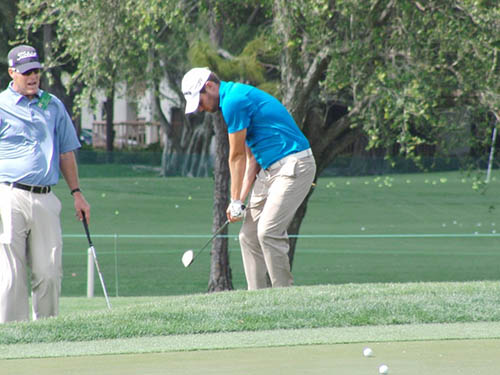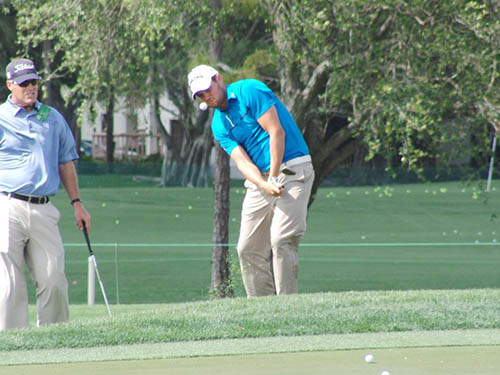When a Collapsed Lead Wrist is Good

by Dr. T.J. Tomasi A Legacy Post by Keiser University College of Golf Senior Faculty and Director of Research (1940-2023)
Add H2: Lead Wrist in Golf Swing
The lead wrist in a golf swing is the wrist on the leading arm, which is the left wrist for right-handed golfers and the right wrist for left-handed golfers. During the setup, the lead wrist should be relatively flat, forming a straight line with the forearm. As the swing progresses into the backswing, the lead wrist begins to hinge, creating an angle between the forearm and the club. This hinge is maintained as the swing reaches the top.
During the downswing, the lead wrist starts to unhinge, releasing the stored energy into the ball. At impact, the lead wrist returns to a flat position, ensuring that the clubface strikes the ball squarely. After impact, the lead wrist moves into a slightly bowed position, helping to guide the follow-through. Throughout the swing, the lead wrist plays a dynamic role, adjusting its position and angle in response to the movements of the arms and body. Proper movement of the lead wrist ensures fluidity and efficiency in the swing. The lead wrist must remain flexible yet controlled, adapting to the changes in swing dynamics from start to finish.
Importance of Golf Lead Wrist
The lead wrist in a golf swing plays a crucial role in determining the quality and consistency of ball striking. A properly positioned lead wrist helps maintain the correct clubface angle throughout the swing, ensuring accurate shots. At the setup, a flat lead wrist establishes a strong, neutral position that promotes solid contact. During the backswing, the lead wrist hinges to store energy, which is vital for generating power.
As the swing transitions into the downswing, the lead wrist’s position influences the release of the club, allowing for a controlled and powerful strike. At impact, a flat or slightly bowed lead wrist ensures the clubface is square to the target, which is essential for directional control. Post-impact, the lead wrist continues to guide the club through the follow-through, contributing to the overall fluidity of the swing.
Maintaining the proper lead wrist position throughout the swing helps prevent common errors, such as casting or flipping the club, which can lead to mishits and loss of distance. The lead wrist also plays a significant role in controlling the loft and trajectory of the ball, allowing golfers to shape their shots effectively. Therefore, understanding and practicing the correct movements of the lead wrist is fundamental for any golfer aiming to improve their game and achieve consistent, high-quality shots.
Tips for Lead Wrist in Golf
Here are some lead wrist tips for golfers:
- Monitor Your Grip Pressure: Keeping a consistent grip pressure helps maintain proper lead wrist position throughout the swing, preventing unwanted movements.
- Practice with Slow Swings: Slowing down your swing during practice can help you focus on the lead wrist position, ensuring it stays flat at the right moments.
- Utilize Wrist Hinge Drills: Specific drills that emphasize wrist hinge can train your lead wrist to move correctly during the backswing and downswing.
- Check Your Setup: At address, ensure your lead wrist is in a neutral position, neither too flexed nor too extended, to set the foundation for the swing.
- Use Training Aids: Tools like wrist braces or impact snap devices can provide feedback on lead wrist position, helping to ingrain the correct movements.
- Visualize Your Swing Path: Mentally rehearsing the swing with a focus on lead wrist positions can improve muscle memory and execution during actual swings.
- Seek Professional Feedback: Working with a golf instructor can provide personalized tips and corrections for maintaining the proper lead wrist position.
- Regularly Review Swing Footage: Recording and analyzing your swing can help identify any inconsistencies in your lead wrist movement, allowing for targeted adjustments.
Most of the time, for both full shots and short pitches/chips, it’s best to prevent your lead wrist from collapsing. The reason is that when you create a cup in the lead wrist, you change the loft of the clubface. The result is that the club flips past you, and the increased loft added by the flip causes the ball to come up short. But there is one situation in which the breakdown of the lead wrist should be encouraged as good technique – when you are near the green and need a very high, soft-landing shot, but you can’t risk a long, lazy backswing.
Here’s how it works:
- Place most of your weight on your lead foot.
- Use a very weak grip.
- Take a short but smooth backswing.
- As you go through the shot, stop your lead arm, and allow the lead wrist to buckle without turning over.

Note: It may feel like a flip, but what you want is a special kind of flip called The Forward Flip (FF), where the face stays looking at the target. Incorrectly done, the forearms rotate shutting down both the lift and its direction. This results in a low pull. To produce the FF, there is no forearm roll, but there is a breakdown of the forward wrist (see photo). The result is the low clubhead speed and extra loft needed for a soft shot. This technique is especially useful out of the Bermuda rough around the greens. To add this shot to your arsenal, you have to practice the technique, but when you get it under control, it’s a valuable go-to weapon.

Learn more!
Want more tips? If you want to take your game to the next level, contact our team at Keiser University’s College of Golf & Sport Management today. With our dedication and experience, we can elevate your game to new heights together. Give us a call today at 888-355-4465.














